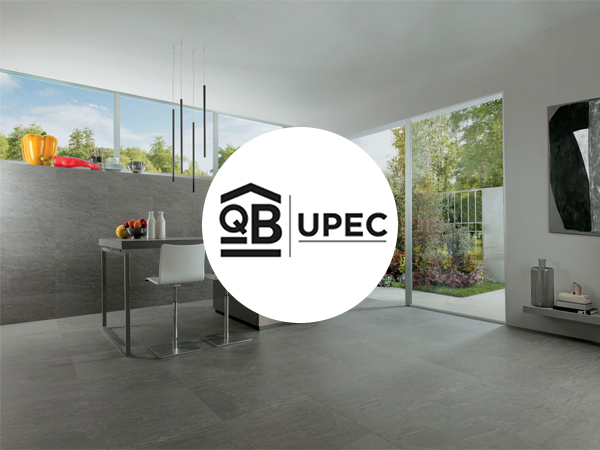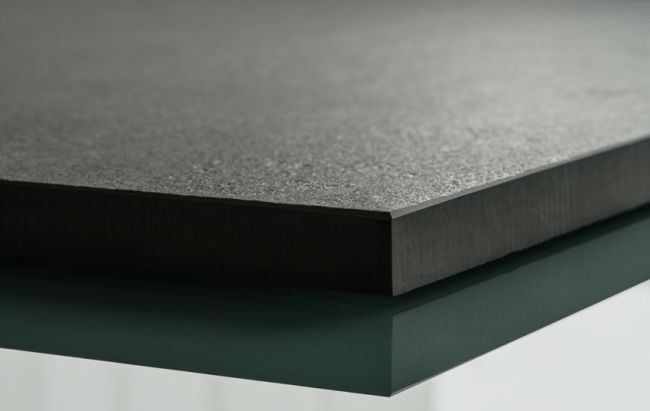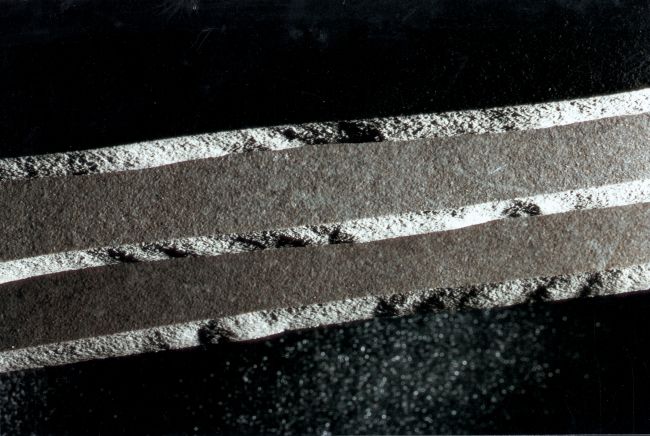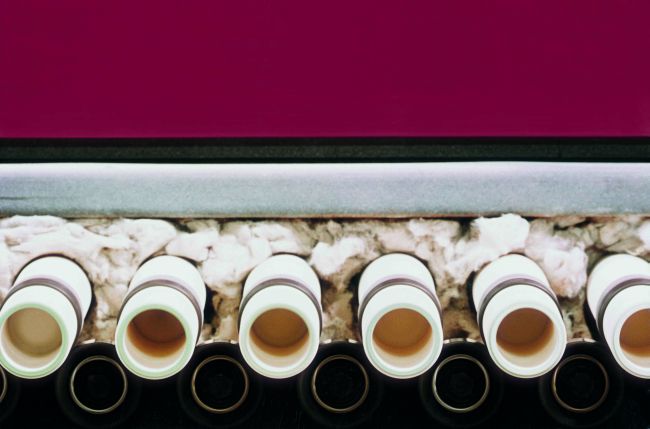Most of Novoceram flooring products are marked by a code of eight characters[1] that seem mysterious but which, in reality, summarizes their technical features and usability. This is the UPEC classification, and is composed by the letters U, P, E and C, each followed by a number (for example, U4P4E3C2). But what is the UPEC, and how should you correctly interpret this acronym?

- What is UPEC?
- The classification of rooms and products
- Two examples
- The certification of ceramic tiles
- How to choose?
- Which Novoceram products are certified?
- Conclusion

What is UPEC?
The UPEC classification for the use of flooring products, is a functional classification system that certifies whether a flooring product is suitable for use in a certain room for a sufficient and reasonable time, given that:
- each room is characterized by different degrees of mechanical, physical and chemical stresses that contribute to the damage of pavements
- each flooring system presents different degrees of resistance to these mechanical, physical and chemical agents of deterioration.
The classification of rooms and products
The UPEC system’s operating logic is simple: each private, commercial or public room with predominantly pedestrian traffic (thus does not refer to flooring intended for frequent and prevalent circulation of cars) is classified on the basis of the stresses to which it is likely to be subjected during its normal use, based on four aspects (the four letters, of course):
U: it indicates trampling wear, occurring in the real surface abrasion or even in the change of the surface aspect itself (gloss loss, changes in colour, etc..) The index U can go from 2 (minimum stress) to 4.
P: (punching) it indicates the mechanical stresses to which the floor is expected to be subjected. These stresses can be caused by mobile or fixed furnishings (pieces of furniture, carts, cleaning equipment, etc..) or objects falling on the floor (kitchen pots and crockery, for example). The index P ranges from a minimum of two (minimum stress) to a maximum of 4s.
E: it indicates the presence and frequency of water on the floor, and it is related in particular to the washing system. This index ranges from a minimum of 1 to a maximum of 3.
C: it indicates the resistence to chemical and staining substances that can leave permanent stains on the floor. The index C ranges from a minimum of 0 (lowest risk) to 2 (exceptionally 3 for particular rooms, as some laboratories).
All the rooms have been classified with regard to these four parameters. When a flooring product (a new collection of Novoceram tiles, for example) is sent to the CSTB (the agency that issues the UPEC certification), it undergoes a predefined set of tests able to classify its technical characteristics and functional criteria with respect to U, P, E, and C by assigning to each a value that represents the ability of the product to resist the related stresses.
It sounds complicated but is very easy: you just have to choose a product that has a UPEC equal to or greater than the one required by its place of destination.
The complete list of room classification is available on the CSBT website at http://webapp.cstb.fr/upec/Docs/cahier_3509.pdf. This classification is still under revision and a new version of the document will be scheduled at the beginning of 2015.

Two examples
Here is an example of a classification of three rooms with different needs:
– the bath of a private house: U2sP2E2C1. The stress due to trampling (U) is slightly higher than the minimum required and the one due to punching (P) is at a minimum. Obviously the water presence on the floor is at a minimum level and it is indicated with E2 which means « frequent but not systematic presence of water. Wet routine cleaning by washing. » Not even the presence of chemical agents is 0 (harsh detergents, cosmetics, dyes …)
A product classified – for example – U3P2E2C2 is appropriate for this destination. A product classified U4P4E1C1 would not: it is extremely resistant to trampling and to mechanical stresses (and therefore it would be appropriate) but is not sufficiently performing regarding water resistance (E1 instead of E2)
(Note: This is a hypothetical case. Virtually all products from Novoceram floor range can be used in this situation. Among the UPEC certified Novoceram products, only a few articles of Iridium 20×20 single firing have a U less than 3, while all have a P greater than or equal to 3 (except the planks in size 15×90) All Novoceram products have E = 3 and C = 2!)
– the toilets of a public exercise: U4P3E3C2. This is a bath, but the stresses required for this type of places are much more intense than the bath of a private house! The stress due to trampling is expected to be in the highest degree (many people come every day, perhaps with dirty shoes: dirt is a powerful abrasive!) – envisaged mechanical stresses too are high (for example, it is likely being used trucks for cleaning), the presence of water is intense and constant (mainly because the cleaning is carried out with frequent wet washing), and the presence of chemical products is usual – typically cleansers and disinfectants used for cleaning.
Neither of the two hypothetical products of the previous example would be suitable for this target: the technical features required in this case are very selective with respect to the products that you can use. In the Novoceram catalog, however, there is plenty of choice: all products of Novoceram in technical porcelain stoneware and almost all of the products of Novoceram in colored in body porcelain stoneware could be used in this situation.
The certification of ceramic tiles
All ceramic tiles are classified at the highest level of resistance both to the parameter E (water) and to the parameter C (chemical agents). It is good news. If you choose a porcelain or a single-fired tile you do not have to worry about these parameters: they are all suitable.
The difference concerns instead the first two parameters: P (mechanical stress) and – most importantly – U (trampling).
Regarding the resistance to mechanical stress (P) this depends both on the thickness of the tile (its resistance increases with a greater thickness), and its size of the same (larger sizes reduce the tile resistance).
Novoceram tiles however have a classification equal to or greater than P3, which means that all can be normally used even in situations of high load: in P3 classified rooms it is usual to use chairs on wheels (offices) and transport trolleys or hand-operated cleaning (excluding pallet). In P4 rooms normally circulate forklifts or heavy machines and floors are regularly subjected to high mechanical stresses. Even in these extreme cases, however, all technical stoneware tiles or colored in body equal to or less than 60×60 cm can easily be used.
With regard to the resistance from trampling, the situation is more varied: all technical porcelain tiles are U4 . Among the porcelain colored in body, many are U4, the others are U3. Glazed porcelain tiles are maximum U3S .
Unlike the P, E and C parameters, which only depend on the physical characteristics of the product , U is closely related to the aesthetic appearance of the product surface , the specific resistance of the surface and its coherence with the underlying mass . The tests – different depending on the type of tiles – are all designed to bring the tile in a cycle of stress comparable to what you would experience throughout the years of use in work and they evaluate their strength .
A priori , technical in-body porcelain stoneware tiles are the best performing tiles: the surface is particularly resistant and moreover the whole mass of the tile is identical to the surface , so even slight trampling is almost imperceptible.
Novoceram however constantly works to study materials , mixtures and surfaces that ensure a wear resistance sufficient enough to ensure the classification U4 also for decorated tiles . Today, most of the colored in body porcelain tiles of Novoceram can guarantee a level of trampling resistance of U4 , the same technical products undecorated , together with an aesthetic richness , a variety of surfaces and the possibility of a very wide choice .
How to choose?
But then, why not always choose a U4P4E3C2 product in all situations in order to feel safe? Often, it is simply unnecessary to choose a high-performance product. A glazed product, typically classified U3, is perfectly suitable for use in an interior domestic setting and it can be cheaper (or you might just like it more) than an U4 high range item. Of course, in an airport it could be ruined too quickly, but in a private home will it remain as new for many years. The standard classification UPEC, indeed, classifies these spaces at a maximum of U2sP2E1C0.
Which Novoceram products are certified?
Leafing through the Novoceram catalog we realize that not all the products have a UPEC certification. Why aren’t some items certified? There may be several reasons:
– The UPEC certification covers only flooring products. The wall products are not certified.
– Honed or polished tiles are not certified. The polishing of the surface (lapping or sanding) is done through a mechanical treatment using abrasive brushes: tiles that undergo this treatment have technical characteristics inferior both in terms of resistance to trampling wear (a minimum gloss loss is immediately detectable in comparison with the surrounding area), and in terms of resistance to chemical agents. Despite these tiles are normally used – with the proper care – in commercial and domestic environments, Novoceram chose not to convey them the UPEC certification.
– Until 2013 it was not possible to certify the tiles that had a ratio between the long side and the short side higher than 3. This meant that all the products in sizes 15×90 and 22,5 x90 (typically, the size of ceramic wood) could not be certified. Today, the legislation was amended and it is finally possible to convey the UPEC certification to these items as well.
In other cases, the UPEC certification of an article is not available simply because the certification process is in progress. This process may take several months and it is not allowed to publish the UPEC of those articles that do not possess the official certificate issued by CSTB yet: while in the past the indication of the UPEC classification claimed on the basis of in-house tests was accepted, nowadays no form of self-certification is allowed.
Conclusion
Although it is not compulsory to have an item classified according to UPEC standards, this classification means giving a customer the opportunity to choose an appropriate product for the intended use. On the one hand, the customer will be sure to have a product that will withstand many years unaltered the stresses to which it will be subjected, while on the other hand he will not be forced to choose a product with technical performance totally unnecessary for the situation of use (and maybe unnecessarily expensive), sacrificing even particular aesthetic characteristics.
NOTE
1. ^ In fact in some cases can be more than 8 characters (some classifications require a « + » or an « s » next to the number).

